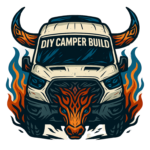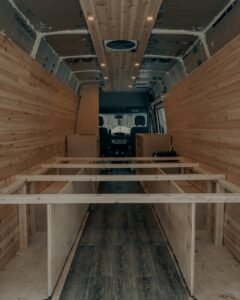Picture this: you’re nestled in your cozy van bed, a frosty winter wind howling outside. But the cold air seems to be seeping right in, turning your dream getaway into a shivering nightmare.
The culprit? A lack of proper insulation, a common problem for van lifers and weekend warriors alike. But there’s a solution hiding in plain sight: the van partition wall.
This often-overlooked upgrade goes beyond separating cargo. A well-insulated partition wall acts like a thermal shield, creating a warm and comfortable haven in the front cabin, regardless of the temperature outside. Imagine enjoying a steaming cup of coffee in your toasty driver’s seat while the back remains a functional storage area.
Stick around as we delve into the world of van partition walls and explore how they can transform your van into a truly climate-controlled adventure mobile.
Adding a partition wall to your camper van build will increase insulation (from the cabin), increase privacy and it can also increase the safety of your van. Some van lifers opt out of the van partition wall to keep their space more open and complement it with swivel seats. It’s definitely a personal choice, but there are LOTS more possibilities for customization with a van partition wall (you can add cabinets, an L-couch/bench, etc…). It’ll also cost you MUCH less than those swivel seats, so let’s get building!
Cutting the van partition wall
Let’s ditch the bulky and expensive aftermarket bulkheads. We’re building a custom partition wall using good ol’ 5/8″ plywood, creating a cozy and insulated haven in the front of your van.
The key challenge here is getting the perfect fit around those lovely curved van walls. Here’s how we’ll tackle it with some clever tricks:
Materials:
- Plywood sheets (5/8″ thickness is a good starting point) – amount will depend on your van size
- Wood screws (appropriate length for your chosen plywood thickness)
- Saw (circular saw or jigsaw for cutting curves)
- Drill and driver
- Sandpaper (various grits)
- Optional: Trim (wood or other material to cover raw edges)
Step 1: Measure Twice, Cut Once (But Leave Some Room for Error)
Accuracy is essential, but even the most meticulous DIYer can encounter a slight miscalculation. Here’s how to create a template with some wiggle room:
- Grab some cardboard or heavy wrapping paper. Tape large sheets together to cover the entire area where your partition wall will be.
- Trace the Van’s Curves: Carefully trace the van’s wall contours onto the cardboard, marking the floor, ceiling, and sidewall contact points. Pro Tip: Leave an extra inch or two of material around the traced outline. This buffer zone gives you some room for adjustment when cutting the plywood.
- Double-Check! Once you have your traced outline with the extra material, cut it out and test it in place. This ensures a snug fit before you move on to cutting the actual plywood.
Step 2: Cutting the Plywood with Symmetry in Mind
Now comes the magic (and maybe a little sawdust).
- Transfer the Template: Carefully lay your cardboard template onto the plywood sheet and trace the outline, keeping the extra material intact for now.
- Embrace the Curves: Using your saw of choice, carefully cut along the traced lines for the curves. A jigsaw is your friend here.
- Symmetrical Savings: If your van layout is symmetrical (driver and passenger sides are identical), you can use the first plywood piece as a template for the second. Simply lay the completed piece on top of another sheet of plywood and trace the outline for a perfect mirror image.
- Refine and Sand: Once all your pieces are cut, use the leftover cardboard template to refine the straight edges of the plywood. This ensures they line up precisely. Then, take some time to sand down any rough edges on your plywood pieces. This will make for a cleaner final product and easier application of any trim you might choose.
Step 3: Building Up Your Wall (Coming Soon!)
We’ve got the basic structure of our partition wall with some clever wiggle room for a perfect fit. The next section will dive into attaching it to the van frame and explore some insulation options. Stay tuned for part two, where we’ll transform this plywood masterpiece into a functional and insulating barrier!
Installing the van partition wall
We’ve got our precisely cut plywood pieces ready to go. Now comes the exciting part: transforming them into a functional and insulating barrier in your van!
Safety Disclaimer: Before diving in, it’s important to acknowledge that modifying your vehicle can impact its safety. Always consult a professional or reference reputable van conversion resources for your specific van model to ensure proper installation techniques prior to making any modifications.
Installation:
Here’s where we’ll secure our custom partition wall to the van frame. Remember, a secure installation is crucial for both functionality and safety.
Materials:
- Wood screws (appropriate length and sturdiness for your chosen materials)
- Metal screws (for attaching directly to the van frame, if applicable)
- 2×4 lumber (length will depend on your van’s dimensions)
- Drill and driver
Steps:
- Securing the Bottom:
- 2×4 Support: Attach a 2×4 stud to the van floor, running horizontally across the width of the partition wall (think of it like a long floor joist). Use appropriate fasteners to securely screw the 2×4 to the van’s floor frame. This will provide a solid base for your partition wall.
- Attaching the Wall: Now, pre-drill holes in the bottom of your plywood partition wall and screw it securely into the top of the 2×4 stud.
- Securing the Top:
- Top Attachment Method 1 (Ford Transit Example): If your van has a gap between the top of the wall and the ceiling, you’ll need to create a support structure. Here, another 2×4 can be used, positioned vertically on either side of the partition wall, bridging the gap and securely fastened to the ceiling frame. Then, screw the top of your partition wall into these vertical 2×4 supports.
- Top Attachment Method 2 (General): If your van allows for it, you might be able to directly screw the top of the partition wall into the van’s existing ceiling frame using metal screws. Ensure you’re using appropriate screw lengths to securely fasten the wall to the metal frame.
Pro Tip: Double-check your work throughout the process. Ensure your partition wall is level and plumb before fully tightening all the screws.
We’ve built and secured the basic structure of our partition wall, and even explored some insulation options. But the fun doesn’t stop here! In part 3, we’ll delve into adding finishing touches, like trim and potential cutouts for features like windows or doors. Stay tuned for the final chapter in creating your very own customized van partition wall!
Insulating the van partition wall
We’ve secured the framework of your partition wall, and now it’s time for the real star: insulation! Here, we’ll delve into SONOpan, a popular choice that offers both thermal and sound dampening properties, perfect for creating a cozy and comfortable haven in your van.
Why SONOpan?
SonoMatt goes beyond simple insulation. Here’s why it might be the perfect fit for your van partition wall:
- Multi-Functional: Provides excellent thermal insulation to regulate cabin temperature, while also dampening unwanted road noise for a quieter driving experience.
- Aesthetics Matter: Unlike some insulation materials, SONOpan offers a more finished look.
Installation:
- Optional Base Layer: If you prioritize maximum insulation, you can consider adding a thin layer of XPS foam between the first plywood sheet and the SONOpan for the cabin side.
- Attach SONOpan: Secure the SONOpan sheets directly to the first layer of plywood using appropriate fasteners or construction adhesive.
- Black Fabric Finish (Optional): For a truly polished look, cover the exposed SONOpan surface with black fabric. Use a staple gun or upholstery adhesive to create a sleek and finished appearance.
Back Wall Insulation:
While our primary focus is on insulating the driver’s cabin for temperature control, the back section of your van offers a blank canvas for customization. Here are some popular options for finishing the exposed plywood on the back wall:
- 1×4 Wood Boards: Attach 1×4 boards vertically or horizontally for a classic wood-paneled look. You can paint or stain them to match your van’s interior design.
- SonoMatt with Fabric Expansion: Extend the SONOpan and black fabric treatment used on the cabin side to the back wall for a uniform and aesthetically pleasing finish. This option provides additional sound dampening throughout the entire van.
- Paint or Stain: For a simple and budget-friendly approach, consider painting or staining the exposed plywood. This allows you to personalize the space and match your overall van theme.
Remember:
- Always ensure proper ventilation within your van, regardless of the insulation materials used.
- Research and choose insulation materials with a fire rating for added safety in your vehicle.
Up Next: Putting on the Finishing Touches! In the next section, we’ll explore some additional customization possibilities for your partition wall, including potential cutouts for features like windows or doors!
Summary
So there you have it! With a well-insulated van partition wall, those frosty nights won’t stand a chance. You’ve built a cozy haven in your driver’s cabin, ready to take on any adventure, come rain or shine (or even snow!).
Key Takeaways from This Guide:
- Importance of a Partition Wall: Boost comfort and control the climate in your van with a well-insulated partition wall.
- Building Your Wall: Our step-by-step guide empowers you to create a custom partition wall that seamlessly fits your van.
- The Power of SONOpan: Discover how SONOpan offers superior insulation, sound dampening, and a finished aesthetic for your van.
- Creative Finishing Touches: From classic wood paneling to a sleek fabric finish, explore options to conceal the exposed plywood in the back.
Ready to transform your van into a true all-weather adventure machine? We are too!
Don’t miss out on these helpful resources:
- Week 8: Van Seating & Storage Solutions: Maximize your van’s functionality with clever seating and storage ideas for ultimate comfort and organization on the road. (Coming next week!)
- Week 6: Building Your Dream Van Table & Countertop: Craft the perfect workspace for meals, work, or hobbies with our guide to building a custom van table and countertop. (Check it out now!)
Join the DIY Camper Build Community!
Share your van conversion journey, ask questions, and get inspired by fellow vanlifers. We’re here to help you create your dream adventure mobile!





